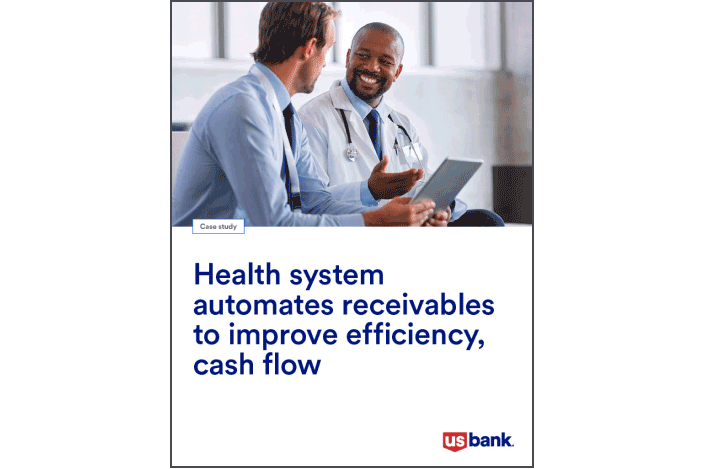Client Story: Adoption of U.S. Bank Payment Consolidator drives A/R efficiencies
- The client: A leading regional healthcare provider
- The challenge: To accelerate cash flow and reduce days in accounts receivable by processing paper documents related to medical claim payments and denials more efficiently
- The solution: Automating and digitizing paper-based payments and correspondence using bank lockbox automation services that eliminate manual payment posting and other labor-intensive activities related to revenue cycle management in healthcare.
In the wake of the pandemic, and the shift to more remote work, an integrated health system with eight hospitals and a high-performance physician medical group was challenged to keep up with the processing of insurer and patient correspondence mailed to its offices. A backlog of denial letters, medical records requests and other claims-related documents was negatively impacting cash flow. Due to the large volume of payer correspondence, items were not worked promptly, and denial appeal deadlines were often missed, resulting in accounts receivable write-offs.
As a user of both patient and insurance payer lockboxes from U.S. Bank, the health system turned to its banking partner for a solution. The health system adopted the U.S. Bank Payment Consolidator healthcare receivables product after learning how the service’s imaging, paper conversion and correspondence auto-routing capabilities could address its paper documents bottleneck.
One of the most time-consuming aspects of working the correspondence was initially sorting through all the paper to identify the correct team member for distribution. Different team members manage and resolve distinct types of correspondence, such as bankruptcy letters, attorney inquiries and Medicare notifications. Payment Consolidator streamlines processing by creating images of all the correspondence, auto-categorizing it by type of inquiry, and then presenting it in an online workflow queue to be worked by a team member dedicated to resolving that type of document.
Within months of adopting Payment Consolidator, the simplified online workflows enabled the health system to eliminate its backlog of paper correspondence. Utilizing the auto-routed queues has created a more timely, accurate and consistent method of handling and resolving correspondence, resulting in fewer hands needed and faster receipt of payment.
Conversion and auto-matching
The health system also immediately benefited from the Payment Consolidator platform’s conversion services. The remittance information is lifted through optical character recognition (OCR) to create electronic posting files for both insurance explanations of benefits (EOBs) and patient payments that are imported into the organization’s electronic medical records platform. This results in manual payment posting for only a small percentage of exception work rather than for 100% of all items received in the lockbox.
Prior to adopting Payment Consolidator, locally received paper checks and EOBs were held until manual matching processes occurred and a deposit was made. The paper checks and EOBs were held in folders by posting team members and not always matched in a timely way, creating stale-dated checks and additional rework. Now those items are forwarded to the lockbox for immediate deposit and more timely lockbox processing.

This case study is also available as a PDF.
Would you prefer to read this case study as a PDF or print it and read later?
Dramatically improved processes and results
Within a few months, the correspondence backlog was eliminated, payments were being posted four to seven days faster, and over 90% of previously posted manual payments were being automatically posted. Faster correspondence resolution also resulted in accelerated collections and an improved cash flow position, a reduction in days in accounts receivable, and a more effective claim payment document inventory management process.
Today, the organization’s staff is more efficient, payments are posted quicker, correspondence is resolved faster, and the revenue cycle management team has a consolidated view of all claims-related remittance and payment information in one easy-to-use portal. Everything is visible in Payment Consolidator and no longer hidden in an offline folder.
The robust reconciliation reporting and other analytical dashboards available in the Payment Consolidator portal can be used to monitor worked and unworked items easily and effectively. Tracking of funded and non-funded remittance information is much more efficient.
The standard archival period for all images and related remittance information is seven years. The ability to search by patient name, payer name and other healthcare focused indexes, in addition to basic date and dollar amount, improves efficiencies in customer service and collections..
Reallocating staff for greater efficiency
Automating correspondence management and paper-based payment posting has produced greater staff efficiency. Resources previously dedicated to handling mail, scanning documents and other administrative tasks were reassigned to other activities that create a leaner and more effective operational workflow for the revenue cycle team.
A partnership that supports healthcare innovation
Because strong cash flow is vital to maintaining the health system’s financial viability and position as a leader in the industry, accounts receivable automation has become a pivotal strategy. Through its partnership with U.S. Bank, the organization continues to drive its automation strategy toward accelerated collections by leveraging technological advances in healthcare payment automation platforms that provide innovative process improvements.
Let’s talk about optimizing your receivables.
The U.S. Bank team is here to help you with healthcare receivables automation, process improvement and finding efficiencies.




